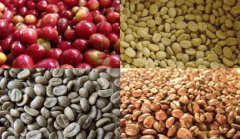A brief introduction to the History and Culture of the Origin and Development of Costa Rican Saint Roman Coffee with rich flavor

All the coffee trees planted in Costa Rica are Arabica coffee trees. through improvement, the quality of coffee beans is better and more stable. in order to facilitate picking, coffee trees are kept at a height of about 2 meters through continuous pruning. The coffee that people eat is the taste of the seeds in the fruit that are brewed in water. After picking raw coffee beans, the seeds (that is, coffee beans) can be roasted only by peeling, pulp, seed film and sun exposure. now part of the process can be replaced by machines, and the speed of coffee production has increased a lot. However, there is no machine to do coffee picking. We must use manual work, the most famous of which is mountain Costa Rican coffee, which tastes mellow and neutral, and it can be boiled directly. Or mixed with other kinds of coffee beans into mixed coffee, is also a good choice.
Other kinds of Brazilian coffee, such as Rio and Parana, can be produced in large quantities because they do not require too much care. Although the taste is rough, it is a kind of high-quality and inexpensive coffee, which has its own standards because it is distributed all over the country and varies in quality (NO.2~NO.8 according to the number of sundries, NO.13~NO.19 according to the size of beans, and six grades according to taste). Almost all Arabica varieties are of good quality and stable in price. The most famous one is Costa Rica, which has been a necessity of blended coffee and is familiar to the public since ancient times.
Excellent Costa Rican coffee is called "extra hard beans". This kind of coffee can grow above 1500 meters above sea level. Altitude has always been a problem for coffee growers. The higher the altitude, the better the coffee beans, not only because the higher altitude can increase the acidity of the coffee beans and thus increase the flavor, but also because the night temperature at the higher altitude is lower, which can make the trees grow slowly, thus the flavor of the coffee beans is stronger. In addition, due to the high altitude drop caused by sufficient rainfall, it is very beneficial to the growth of coffee trees. However, its negative effect is to increase additional transportation costs, which is likely to make coffee production unprofitable. The coffee industry in Costa Rica has adopted new technologies to increase efficiency, including using "electric eyes" to select beans and identify coffee beans of irregular size.
Costa Rica accounts for only 0.03% of the world's land area, but with nearly 4% of the world's species, Costa Rica is one of the countries with the richest biological species in the world. 26% of the land area is a national park or nature reserve, including 11 wetlands, 2 biological reserves and 3 World Natural Heritage sites. The national forest coverage rate is 52%.
Natural resources include iron, manganese, mercury, bauxite, gold and silver, among which the reserves of bauxite, iron and coal reach 150 million tons, 400 million tons and 50 million tons respectively. The recent situation is mainly distributed in the central gold belt area of the northwestern Tilaran Cordillera Mountains. Calcium carbonate is distributed in the northwest and has high taste. The purity of calcium carbonate extracted from limestone can reach 99.5%. Costa Rica attaches great importance to environmental protection and the exploitation of natural resources is strictly restricted.
Oil is completely dependent on imports, mainly from Colombia and other countries, and is monopolized by the National Oil Company (RECOPE), with an average annual import of 3 million tons of crude oil. Since 2012, the national oil company has suspended crude oil refining production due to aging facilities, and all fuel oil has been imported instead. In 2013, Costa Rica imported 19.3 million barrels of oil, worth US $2.3 billion, accounting for 5.5% of GDP. The Costa Rican government has 21 ministries, namely: the Ministry of Foreign Affairs and religious Affairs, the Ministry of the President, the Ministry of Internal Affairs, the Police and the Ministry of Public Security; the Ministry of Finance, the Ministry of Foreign Trade, the Ministry of economy, Industry and Commerce; the Ministry of Planning and Economic Policy; the Ministry of Health; the Ministry of Science and Technology; and the Ministry of decentralization and Local Development Ministry of Social Welfare and Family; Ministry of Public works and Transport; Ministry of Public Education; Ministry of Housing and settlement; Ministry of Environment and Energy; Ministry of Labour and Social Security; Ministry of Culture and Youth; Ministry of Agriculture and Animal Husbandry; Ministry of Justice and Peace; Ministry of Sports; Ministry of Tourism. [5]
Cabinet
President: head of state or government, elected by direct election by the whole people, for a term of four years, not re-elected, but re-elected at alternate terms. Luis Guillermo Solis (Luis Guillermo Solis), a member of the Civic Action Party, was sworn in as the 16th President of the second Republic until May 2018 after winning the second round of the general election with 77.8% of the vote on 6 April 2014. [5]
Cabinet: 2 vice presidents and 21 ministers. The vice president is elected together in the presidential election, and the ministers are appointed by the president. When the president is absent, the first and second vice presidents and the speaker take over at one time. In the Solis cabinet, first Vice President and Minister of Finance Elio, second Vice President Anna Elena Chakon, Minister of Foreign Trade Alexander, Minister of economy, Industry and Commerce will Moramos, Minister of Planning and Economic Policy Olga Marta Sanchez, Minister of Public works and Transportation Ross Signini, Governor of the Central Bank Oliver, President of the State Power Telecommunications Corporation Carlos Manuel
One of the most famous is Mountain Costa Rica Coffee, which tastes mellow and neutral. It can be boiled directly or mixed with other kinds of coffee beans into mixed coffee. It is also a good choice.
Other kinds of Brazilian coffee, such as Rio and Parana, can be produced in large quantities because they do not require too much care. Although the taste is rough, it is a kind of high-quality and inexpensive coffee, which has its own standards because it is distributed all over the country and varies in quality (NO.2~NO.8 according to the number of sundries, NO.13~NO.19 according to the size of beans, and six grades according to taste). Almost all Arabica varieties are of good quality and stable in price. The most famous one is Costa Rica, which has been a necessity of blended coffee and is familiar to the public since ancient times.
Excellent Costa Rican coffee is called "extra hard beans". This kind of coffee can grow above 1500 meters above sea level. Altitude has always been a problem for coffee growers. The higher the altitude, the better the coffee beans, not only because the higher altitude can increase the acidity of the coffee beans and thus increase the flavor, but also because the night temperature at the higher altitude is lower, which can make the trees grow slowly, thus the flavor of the coffee beans is stronger. In addition, due to the high altitude drop caused by sufficient rainfall, it is very beneficial to the growth of coffee trees. However, its negative effect is to increase additional transportation costs, which is likely to make coffee production unprofitable. Costa Rica's coffee industry has adopted new technologies to increase efficiency, including using "electric eyes" to select beans and identify irregular-sized coffee beans. Costa Rica's Tarrazu is one of the major coffee producers in the world, producing coffee with a light flavor and pleasant aroma. Costa Rica, with its fertile volcanic soil and good drainage, is the first country in Central America to grow coffee and bananas for commercial value. Coffee and bananas are the country's main exports. Coffee was introduced into Costa Rica from Cuba in 1729. Today, its coffee industry is one of the well-organized industries in the world, with a yield of 1700 kg per hectare. Costa Rica, with a population of only 3.5 million, has 400 million coffee trees, and coffee exports account for 25 per cent of the country's total exports. Costa Rica has also benefited from the establishment of the Central American Institute for Agricultural Research (TurrialbaoftheCentralAmericanAgriculturalResearchInstitute, referred to as IAAC) in Tarasu, which is an important international research centre.
High-quality Costa Rican coffee is called "extra hard beans". This kind of coffee can grow above 1500 meters above sea level. Altitude has always been a problem for coffee growers. The higher the altitude, the better the coffee beans, not only because the higher altitude can increase the acidity of the coffee beans and thus increase the flavor, but also because the night temperature at the higher altitude is lower, which can make the trees grow slowly, thus making the coffee beans have a stronger flavor. In addition, due to the high altitude drop caused by sufficient rainfall, is also very beneficial to the growth of coffee trees. However, while there are many advantages to growing coffee at higher elevations, the resulting additional transport costs must be taken into account, which is likely to make coffee production unprofitable. The coffee industry in Costa Rica has adopted new technologies to increase efficiency, including the use of "electric eyes" to select beans and identify coffee beans of irregular size.
Costa Rica is located in the Central American isthmus, belonging to North America, latitude 10 °north, longitude 84 °west. It is bordered by the Caribbean Sea to the east and the North Pacific Ocean to the west, with a coastline of 1290 km (212km on the east coast and 1016 km on the west coast). Costa Rica borders Nicaragua in the north (309 km long border) and Panama (639 km long border) south-southeast. There are a total of 51100 square kilometers, of which the territory is 50660 square kilometers and the territorial sea is 440 square kilometers, which is slightly smaller than West Virginia in the United States and is quite different from the climatic conditions of Ireland and Costa Rica, completely subverting the classification of the four seasons of the year. There are only two seasons, the rainy season from April to December, with more rain, and the dry season from the end of December to April of the following year, also known as summer. The annual average temperature in San Jose, the capital, ranges from 15 ℃ to 26 ℃. The temperature in the coastal areas is relatively high. The average night temperature in the Caribbean is 21 ℃, and the daily average temperature is 30 ℃. It is called the Legislative Assembly, the unicameral system, the barber assembly, the exercise of legislative power and other important functions and powers. Major government decisions need to be examined and approved by the Legislative Assembly, which is called the "first power" of the country. It is the highest legislature in the country, composed of 57 members. Members are directly elected by voters for a term of four years and are non-re-elected. The current Legislative Assembly was formed in May 2010. the new Legislative Assembly was elected on February 2, 2014. the election results are as follows: 18 seats for the ruling National Liberation Party (PLN), 12 seats for the Civic Action Party (RAC), 4 seats for the Free Movement Party (PML), 8 seats for the Christian Social Solidarity Party (PUSC), and 1 seat for all the people to join the Party (PASE). Broad Front Party (FA) 8 seats, National Reform Party (RN) 1 seat, Costa Rican Reform Party (RC) 1 seat, Christian Democratic Union (ADC) 1 seat and 2 independent parliamentarians. The current chairman is Luis Fernando Mendoza Fernando Mendoza Jimenez of the National Liberation Party, who was elected in May 2013 for an one-year term. On May 1, 2014, the Legislative Assembly completed its new session.
The newly developed villa sarchi planting, breeding and quality inspection research institutions, in addition, it also has 10 hectares of experimental plots, planting a number of excellent varieties. Coffee is Costa Rica's main agricultural product, with an annual output of more than 2 million bags (60 kilograms) and foreign exchange earnings of 250 million US dollars, second only to pineapples and bananas.
Important Notice :
前街咖啡 FrontStreet Coffee has moved to new addredd:
FrontStreet Coffee Address: 315,Donghua East Road,GuangZhou
Tel:020 38364473
- Prev

A brief introduction to the description of the flavor and aroma characteristics of Costa Rican Saint Roman Coffee
The research center, located about 30 kilometers northeast of the Costa Rican capital San Jose, belongs to the Costa Rican Coffee Association and is a research institution for villa sarchi planting, breeding and quality inspection newly developed by Costa Rica's national coffee breeds. in addition, it also has 10 hectares of experimental plots, planting a number of excellent varieties. Coffee is the main agricultural product in Costa Rica, with an annual output of more than 2 million bags
- Next

San Romano Costa Rica, Costa Rica, California
Costa Ricans say coffee has changed the country and made it possible to enjoy a rich environment.Although Costa Rica ranks third from the bottom of the Central American landmass, its economic environment is better than half of that of other countries.Because of its rich people and stable society, Costa Rica has the spare time to care about environmental issues.
Related
- Detailed explanation of Jadeite planting Land in Panamanian Jadeite Manor introduction to the grading system of Jadeite competitive bidding, Red bid, Green bid and Rose Summer
- Story of Coffee planting in Brenka region of Costa Rica Stonehenge Manor anaerobic heavy honey treatment of flavor mouth
- What's on the barrel of Blue Mountain Coffee beans?
- Can American coffee also pull flowers? How to use hot American style to pull out a good-looking pattern?
- Can you make a cold extract with coffee beans? What is the right proportion for cold-extracted coffee formula?
- Indonesian PWN Gold Mandrine Coffee Origin Features Flavor How to Chong? Mandolin coffee is American.
- A brief introduction to the flavor characteristics of Brazilian yellow bourbon coffee beans
- What is the effect of different water quality on the flavor of cold-extracted coffee? What kind of water is best for brewing coffee?
- Why do you think of Rose Summer whenever you mention Panamanian coffee?
- Introduction to the characteristics of authentic blue mountain coffee bean producing areas? What is the CIB Coffee Authority in Jamaica?

